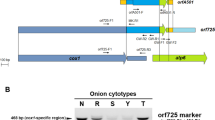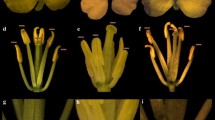Abstract
The Ogura cytoplasmic male sterility (CMS) of radish has been used for hybrid seed production in radish and Brassica crops. It is the only CMS system occurring in wild populations for which the gene responsible for sterility and a restorer gene have been formally identified. In Japan, gynodioecious populations of radish carrying Ogura or an Ogura-related cytoplasm have been described. The occurrence of restorer genes for the Ogura CMS in wild radish (Raphanus raphanistrum) in France led us to search for the corresponding male sterility gene (orf138) in several natural populations in France, England and Lebanon. We detected the orf138 gene, by PCR, at low frequency, in three populations from France and one from Southern England. Further molecular characterization showed that these plants carried a cytoplasm closely related to the original Ogura cytoplasm, with a variant orf138 coding sequence, previously reported to be ancestral. We performed crosses with sterile and maintainer radish lines, to test the ability of this wild Ogura-related cytoplasm to induce sterility. Surprisingly, the European Ogura-related cytoplasm did not cause sterility. Northern blots and circular RT-PCR analyses showed that orf138 gene expression was impaired in these plants because of a novel cytoplasm-dependent transcript-processing site.




Similar content being viewed by others
References
Ausubel FM, Brent R, Kingston RE, Moore DD, Seidman JG, Smith JA, Struhl K (1990) Current protocols in molecular biology. Greene, Wiley Interscience, New York
Bailey MF, Delph LF, Lively CM (2003) Modeling gynodioecy: novel scenarios for maintaining polymorphism. Am Nat 161(5):762–776
Bellaoui M, Pelletier G, Budar F (1997) The steady-state level of mRNA from the Ogura cytoplasmic male sterility locus in Brassica cybrids is determined post-transcriptionally by its 3′ region. EMBO J 16(16):5057–5068
Bentolila S, Alfonso AA, Hanson MR (2002) A pentatricopeptide repeat-containing gene restores fertility to cytoplasmic male-sterile plants. Proc Natl Acad Sci USA 99(16):10887–10892
Bonhomme S, Budar F, Férault M, Pelletier G (1991) A 2.5 kb NcoI fragment of Ogura radish mitochondrial DNA is correlated with cytoplasmic male-sterility in Brassica cybrids. Curr Genet 19:121–127
Bonhomme S, Budar F, Lancelin D, Small I, Defrance M-C, Pelletier G (1992) Sequence and transcript analysis of the Nco2.5 Ogura-specific fragment correlated with cytoplasmic male sterility in Brassica cybrids. Mol Gen Genet 235:340–348
Bonhomme S, Budar F, Lancelin D, Pelletier G (1999) DNA sequence conferring cytoplasmic male sterility, mitochondrial genome, nuclear genome, mitochondria and plant containing said sequence and process for the preparation of hybrids. European Patent EP0909815
Bonnet A (1977) Breeding in France of a radish F1 hybrid obtained by use of cytoplasmic male sterility. Eucarpia Cruciferae Newsl 2:5
Brown GG, Formanova N, Jin H, Wargachuk R, Dendy C, Patil P, Laforest M, Zhang J, Cheung WY, Landry BS (2003) The radish Rfo restorer gene of Ogura cytoplasmic male sterility encodes a protein with multiple pentatricopeptide repeats. Plant J 35(2):262–272
Budar F, Delourme R, Pelletier G (2004) Male sterility. In: Pua EC, Douglas (eds) Biotechnology in agriculture and forestry 54. Springer, Berlin, pp 43–64
Budar F, Touzet P, Pelletier G (2006) Cytoplasmic male sterility. In: Ainsworth C (ed) Flowering and its manipulation. Blackwell, Dordrecht 20:147–180
Charlesworth D (2002) What maintains male-sterility factors in plant populations? Heredity 89(6):408–409
Cui X, Wise RP, Schnable PS (1996) The rf2 nuclear restorer gene of male-sterile T-cytoplasm maize. Science 272(5266):1334–1336
Darwin C (1877) The different forms of flowers on plants of the same species. John Murray, London
Dellaporta J, Wood J, Hicks J (1983) A plant DNA minipreparation: version II. Plant Mol Biol Rep 1:19–21
Desloire S, Gherbi H, Laloui W, Marhadour S, Clouet V, Cattolico L, Falentin C, Giancola S, Renard M, Budar F, Small I, Caboche M, Delourme R, Bendahmane A (2003) Identification of the fertility restoration locus, Rfo, in radish, as a member of the pentatricopeptide-repeat protein family. EMBO Rep 4(6):588–594
Duroc Y, Gaillard C, Hiard S, Defrance MC, Pelletier G, Budar F (2005) Biochemical and functional characterization of ORF138, a mitochondrial protein responsible for Ogura cytoplasmic male sterility in Brassiceae. Biochimie 87(12):1089–1100
Eber F, Chèvre AM, Baranger A, Vallée P, Tanguy X, Renard M (1994) Spontaneous hybridization between a male-sterile oilseed rape and two weeds. Theor Appl Genet 88:362–368
Forner J, Weber B, Wietholter C, Meyer RC, Binder S (2005) Distant sequences determine 5′ end formation of cox3 transcripts in Arabidopsis thaliana ecotype C24. Nucleic Acids Res 33(15):4673–4682
Grelon M, Budar F, Bonhomme S, Pelletier G (1994) Ogura cytoplasmic male-sterility (CMS)-associated orf138 is translated into a mitochondrial membrane polypeptide in male-sterile Brassica cybrids. Mol Gen Genet 243:540–547
Grivet D, Heinze B, Vendramin GG, Petit R (2001) Genome walking with consensus primers: application to the large single copy region of chloroplast DNA. Mol Ecol Notes 1:345–349
Hanson MR, Bentolila S (2004) Interactions of mitochondrial and nuclear genes that affect male gametophyte development. Plant Cell 16 (Suppl):S154–S169
Havey MJ (2004) The use of cytoplasmic male sterility for hybrid seed production. In: Daniell H, Chase C (eds) Molecular biology and biotechnology of plant organelles. Springer, Heidelberg, pp 623–634
Koizuka N, Imai R, Fujimoto H, Hayakawa T, Kimura Y, Kohno-Murase J, Sakai T, Kawasaki S, Imamura J (2003) Genetic characterization of a pentatricopeptide repeat protein gene, orf687, that restores fertility in the cytoplasmic male-sterile Kosena radish. Plant J 34(4):407–415
Krishnasamy S, Makaroff CA (1993) Characterization of the radish mitochondrial orfB locus: possible relationship with male sterility in Ogura radish. Curr Genet 24(1–2):156–163
Kuhn J, Binder S (2002) RT-PCR analysis of 5′ to 3′-end-ligated mRNAs identifies the extremities of cox2 transcripts in pea mitochondria. Nucleic Acids Res 30(2):439–446
Loudet O, Chaillou S, Camilleri C, Bouchez D, Daniel-Vedele F (2002) Bay-0 x Shahdara recombinant inbred line population: a powerful tool for the genetic dissection of complex traits in Arabidopsis. Theor Appl Genet 104(6–7):1173–1184
Lurin C, Andres C, Aubourg S, Bellaoui M, Bitton F, Bruyere C, Caboche M, Debast C, Gualberto J, Hoffmann B, Lecharny A, Le Ret M, Martin-Magniette ML, Mireau H, Peeters N, Renou JP, Szurek B, Taconnat L, Small I (2004) Genome-wide analysis of Arabidopsis pentatricopeptide repeat proteins reveals their essential role in organelle biogenesis. Plant Cell 16(8):2089–103
Murayama K, Yahara T, Terachi T (2004) Variation of female frequency and cytoplasmic male-sterility gene frequency among natural gynodioecious populations of wild radish (Raphanus sativus L.). Mol Ecol 13(8):2459–2464
Ogura H (1968) Studies on the new male sterility in Japanese radish, with special references to utilization of this sterility towards the practical raising of hybrid seeds. Mem Fac Agric Kagoshima Univ 6:39–78
Pelletier G, Primard C, Vedel F, Chétrit P, Rémy R, Rousselle P, Renard M (1983) Intergeneric cytoplasmic hybridization in Cruciferae by protoplast fusion. Mol Gen Genet 191:244–250
Perrin R, Meyer EH, Zaepfel M, Kim YJ, Mache R, Grienenberger JM, Gualberto JM, Gagliardi D (2004) Two exoribonucleases act sequentially to process mature 3′-ends of atp9 mRNAs in Arabidopsis mitochondria. J Biol Chem 279(24):25440–25446
Saur Jacobs M, Wade MJ (2003) A synthetic review of the theory of gynodioecy. Am Nat 161(6):837–851
Terachi T, Yamaguchi K, Yamagishi H (2001) Sequence analysis on the mitochondrial orfB locus in normal and Ogura male-sterile cytoplasms from wild and cultivated radishes. Curr Genet 40(4):276–281
Touzet P, Budar F (2004) Unveiling the molecular arms race between two conflicting genomes in cytoplasmic male sterility? Trends Plant Sci 9(12):568–570
Wang Z, Zou Y, Li X, Zhang Q, Chen L, Wu H, Su D, Chen Y, Guo J, Luo D, Long Y, Zhong Y, Liu YG (2006) Cytoplasmic male sterility of rice with Boro II cytoplasm is caused by a cytotoxic peptide and is restored by two related PPR motif genes via distinct modes of mRNA silencing. Plant Cell 18(3):676–687
Yamagishi H, Terachi T (1994a) Molecular and biological studies on male sterile cytoplasm in Cruciferae. II. The origin of Ogura male sterile cytoplasm inferred from segregation pattern of male sterility in the F1 progeny of wild and cultivated radishes (Raphanus sativus L.). Euphytica 80:201–206
Yamagishi H, Terachi T (1994b) Molecular and biological studies on male-sterile cytoplasm in the Cruciferae. I. The origin and distribution of Ogura male-sterile cytoplasm in Japanese wild radishes (Raphanus sativus L.) revealed by PCR-aided assay of their mitochondrial DNAs. Theor Appl Genet 87:996–1000
Yamagishi H, Terachi T (1996) Molecular and biological studies on male-sterile cytoplasm in the Cruciferae. III. Distribution of Ogura-type cytoplasm among Japanese wild radishes and Asian radish cultivars. Theor Appl Genet 93:325–332
Yamagishi H, Terachi T (1997) Molecular and biological studies on male-sterile cytoplasm in the Cruciferae. IV. Ogura-type cytoplasm found in the wild radish, Raphanus raphanistrum. Plant Breed 116:323–329
Yamagishi H, Terachi T (2001) Intra-and inter-specific variations in the mitochondrial gene orf138 of Ogura-type male sterile cytoplasm from Raphanus sativus and Raphanus raphanistrum. Theor Appl Genet 103:725–732
Acknowledgments
We thank P. Touzet and M. Dufaÿ for useful comments during the preparation of the manuscript. We thank H. Mireau for critical reading of the manuscript. We thank Dr. Bonnet for generously providing the radish maintainer line for Ogura CMS. We also thank P. Saumitou-Laprade for kindly helping us with the choice of sequenced plastid genome regions, and the communication of primer sequences. We would like to thank A.M. Chèvre, F. Eber, P. Touzet, G. Guéritaine, J. Noun L. Geagea, and the Gauguin family for their precious help in the prospecting of natural populations. The Lebanese populations were prospected in the framework of a French-Lebanese program (04EF22/L12) coordinated by M. Durand-Tardif, funded by the “Coopération pour l’Evaluation et le Développement de la Recherche”. SG was supported by a Saint-Exupéry fellowship from the French Embassy in Buenos Aires. YR was supported by a fellowship from the P. R. China.
Author information
Authors and Affiliations
Corresponding author
Additional information
Communicated by C. F. Quiros.
Sandra Giancola and Yong Rao contributed equally to this work.
Electronic supplementary material
Below is the link to the electronic supplementary material.
122_2007_520_MOESM1_ESM.rtf
Electronic Supplementary Data: Comparisons of sequences from individuals of prospected populations of Raphanus raphanistrum for two regions of the plastid genome. (RTF 17.2 KB)
Rights and permissions
About this article
Cite this article
Giancola, S., Rao, Y., Chaillou, S. et al. Cytoplasmic suppression of Ogura cytoplasmic male sterility in European natural populations of Raphanus raphanistrum . Theor Appl Genet 114, 1333–1343 (2007). https://doi.org/10.1007/s00122-007-0520-6
Received:
Accepted:
Published:
Issue Date:
DOI: https://doi.org/10.1007/s00122-007-0520-6




